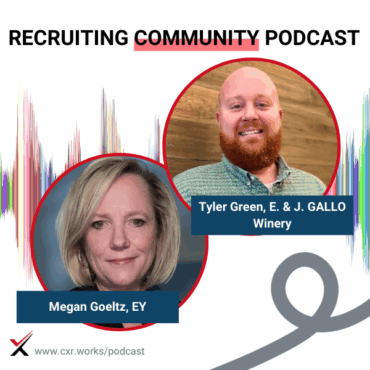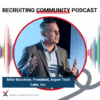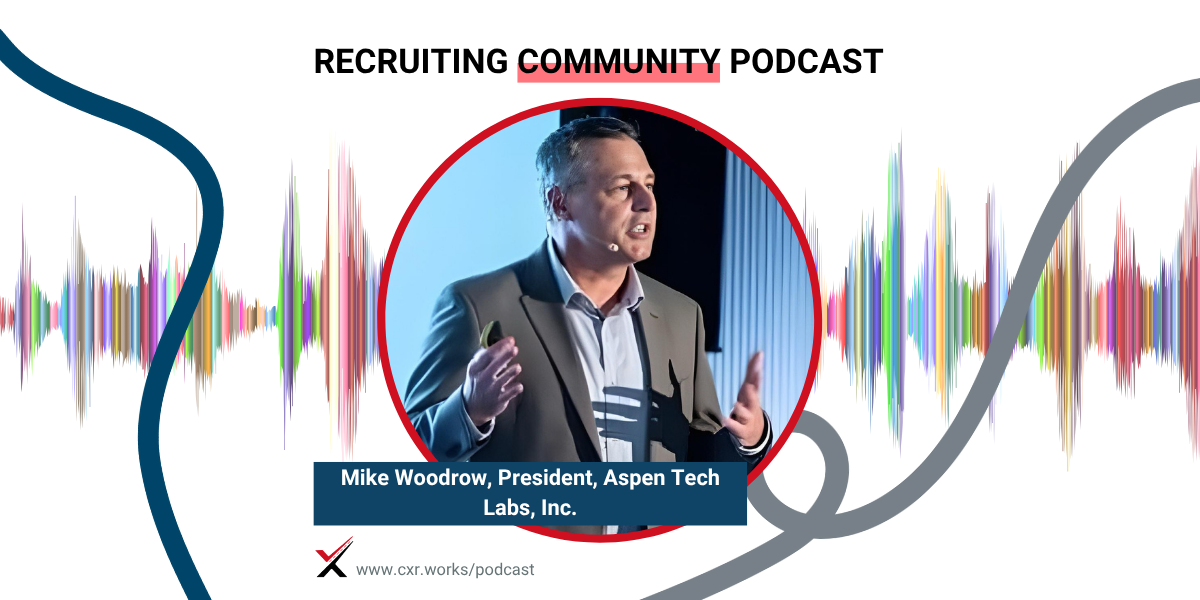
AI Interview Research
How are AI tools reshaping interviews in TA? CXR’s latest research unpacks compliance, candidate behavior, and recruiter workflows in the age of automation.
 play_arrow
play_arrow
Real-Time Jobs Data and the TA Advantage Cami Grace
 play_arrow
play_arrow
20+ Years at Dell and Beyond: Jennifer Newbill’s Career Crossroads Cami Grace
 play_arrow
play_arrow
AI Interview Research Cami Grace
 play_arrow
play_arrow
Solutions Spotlight on Hackajob Cami Grace

Featured Guests:
Michael Woodrow, Co-Founder, Aspen Tech Labs
Hosts:
Chris Hoyt, President, CareerXroads
Gerry Crispin, Co-Founder, CareerXroads
Episode Overview:
Michael Woodrow joins Chris Hoyt and Gerry Crispin to discuss the value of real-time jobs data and how it supports talent acquisition leaders in navigating economic uncertainty. The conversation explores global labor market trends, data sources, and how companies can better leverage competitive intelligence. They also examine the challenges of job description quality, salary transparency, and the strategic use of automation and AI in hiring.
Key Topics:
Global job market trends and regional insights (US, UK, France, Germany)
Comparison of labor data sources: BLS, JOLTS, ADP, private aggregators
Data duplication and methodology concerns in labor market intelligence
The rise of salary transparency and its implications
Importance of accurate and optimized job descriptions
Leveraging real-time data for competitive benchmarking
Adoption of AI and automation in talent acquisition
The impact of Medicaid changes on healthcare hiring
Google for Jobs optimization strategies
Notable Quotes:
“We collect more real-time job data than anyone: more than Indeed, more than the US government.” – Michael Woodrow
“Everyone claims they de-dupe, and I’m sure they try. But when one company’s number is twice everyone else’s, you have to wonder.” – Michael Woodrow
“The sweet spot might be automation up to the point where a human needs to step in.” – Michael Woodrow
“Originally, [job descriptions] came from HR comp teams—boring but clear.” – Gerry Crispin
“Start small. Tackle one function at a time, get wins, then expand.” – Michael Woodrow
Takeaways:
The episode highlights the critical role of high-quality, real-time job data in helping TA leaders navigate volatile markets and make informed decisions. Michael Woodrow emphasizes the importance of sourcing clean data directly from employers, improving job description quality, and optimizing for platforms like Google for Jobs. The discussion also touches on global salary transparency trends and the increasing influence of AI in hiring workflows.
Want more conversations like this?
Subscribe to the CXR podcast and explore how top talent leaders are shaping the future of recruiting. Learn more about the CareerXroads community at cxr.works.
Chris Hoyt: You’re not in your typical work spot. Where are you at today?
Michael Woodrow: Last week I was at Job Boards Connect in London, and I’m working the next couple weeks here in Paris. Most of our team is in Europe, primarily Eastern Europe, so I try to come over a couple times a year for company meetings.
I actually have 45 people in Ukraine, just as an aside. But yeah, I’m in Paris this week—it’s great to be here.
Chris Hoyt: I love that. There’s a lot going on out there! You’ve got Unleash World, the event you’re attending… I kind of feel like I picked the wrong week to stay stateside.
Michael Woodrow: Yeah, I think there are quite a few people over here. I’m actually at an event hosted by a job board vendor called JobiCo. They’re a partner and a customer of ours—we’re a customer of theirs too. There’s a lot of that in the industry.
We saw each other at Job Boards Connect last week in London, and they invited me to a dinner event in Paris. I said, sure. So when we’re done here—it’s a little later for me than it is for you guys—I’m heading over to a restaurant I know well from when I lived here. So yes, definitely some stuff going on over here.
We kind of forget sometimes that the job space is truly global. We can get wrapped up in our own little world of recruiting in Topeka or wherever. But the same principles apply: they’re worried about AI, unemployment rates, too many resumes coming in—same issues we talked about in Park City a few weeks ago.
Chris Hoyt: Yeah, it’s funny. We’re in London next week—I leave in just a couple days. And you’re right, the conversations are almost the same. A lot of concern about AI, fraud, and privacy. Not that different from the US conversations.
But it’s a fun contrast because the prioritization around things like GDPR and transparency, the way data is shared—it’s always a little different when we’re in Europe, and it’s great. It’s great education for us.
Michael Woodrow: For sure. GDPR is definitely a factor. I’m glad we don’t have to deal with it to the same extent in the US. Every time you go to a website over here—CNN or whatever—you get that popup with nine different selections. It’s a lot.
Chris Hoyt: They really don’t make it easy to deselect everything. I just want one big “No” button for it all.
Well, I guess we’ve got some fun stuff to talk about. You guys ready to kick it off?
Announcer: Welcome to the Recruiting Community Podcast, the go-to channel for talent acquisition leaders and practitioners. This show is brought to you by CXR—a trusted community of thousands connecting the best minds in the industry to explore topics like attracting, engaging, and retaining top talent. Hosted by Chris Hoyt and Gerry Crispin, we are thrilled to have you join the conversation.
Chris Hoyt: All right everybody, welcome to the Recruiting Community Podcast. I’m Chris Hoyt, President of CXR. I’m with Gerry Crispin, our Co-Founder. Gerry, say hello.
Gerry Crispin: Hello! Life is good—I can’t complain. Just got back from Rec.
Chris Hoyt: We’re your hosts, and what we do here is bring you industry insights and updates in the form of a conversation. We try to keep it light and engaging—these are usually 20 to 40-minute chats, brought to you by the CXR CareerXroads community.
Today, we’ve got our friend Mike here to talk about how real-time jobs data shapes the economy—and ideally, fuels a competitive edge. I think we’re going to hit on a few “aha” moments for those buried in the day-to-day. We’ll talk about where this data is coming from.
Quick plug—if we’re streaming, we’re on YouTube, Facebook, LinkedIn, and even Twitch. You can also check out cxr.works/podcast for past and future episodes. We’ve got a new design and are coming up on 500 interviews. There are big “like” and “subscribe” buttons to help make us podcast-famous.
Did I miss anything, Gerry?
Gerry Crispin: Nope, I’ve just been growing my beard over those 500. It’s getting long.
Chris Hoyt: For those watching from their treadmill, yes—Gerry’s beard is definitely longer!
All right, Michael—welcome back. You’ve been on before, but it’s great to have you again.
Michael Woodrow: Thanks for having me. I appreciate it.
Chris Hoyt: Give us the elevator pitch. Who is Michael Woodrow? What’s Aspen Tech Labs? Why should we be listening to you today?
Michael Woodrow: I’ve spent most of my career in the recruitment space. I started brokering computer programmers pre-Y2K, then launched an executive recruiting firm around 2001. Got into the job board space soon after and co-founded Aspen Tech Labs in 2008.
We started as a job board provider—think niche boards like nursingjobsinorlando.com. We still do a little of that. But around 2010 or 2011, we pivoted to jobs data.
Our larger customers started asking for high-quality jobs data. So, we built that capability. Today, we’re a labor market intelligence company. We still do web scraping and operate our “Jobs Index,” collecting data from over 225,000 companies every day—globally. We collect more real-time job data than anyone: more than Indeed, more than the US government.
And we take quality seriously. It’s not easy to get clean job data and organize it in a way that you can compare Walmart jobs to Amazon jobs. But that’s what we do.
I’ve been a recruiter, so I get the pain. Now we’re looking at the industry through a data lens, and I’ve got a few things to share today that I think will be useful for TA leaders.
Chris Hoyt: I find that super interesting. We joked about this earlier—no October jobs report. We don’t know what’s coming for November. For a data-driven TA leader looking to stay informed or gain a competitive edge… where do we go?
Gerry Crispin: Even the best TAs have CEOs and CHROs asking important questions. They’re deciding whether to invest, hold off, or pivot. Everyone’s asking, “Who’s hiring?”
Michael Woodrow: Right. The tightness of the labor market is a big deal. Remember post-COVID—everything got really tight, wages surged, CPCs were through the roof.
It’s important for TA leaders to understand what’s happening. But as Gerry said, it’s hard to get your arms around it. So we’ve put together a primer—some slides to show what’s happening, where the data’s coming from, and how to interpret it. It’ll stimulate conversation and give leaders something concrete to respond with when asked.
Chris Hoyt: Yeah, let’s walk through it. You’ve got some interesting findings TA leaders should see.
Michael Woodrow: So first, where does the data typically come from? Historically, it’s been BLS—the Bureau of Labor Statistics. They issue the monthly jobs report, which focuses on unemployment, job openings, hires, quits—it’s all survey-based.
The problem is, they often revise the numbers later. So you get one number, and two months later they go back and change it. Still, it’s the benchmark everyone’s used.
Then you’ve got JOLTS—Job Openings and Labor Turnover Survey—which comes out about five weeks after the month ends. That’s closely watched, especially in financial services.
Weekly unemployment claims are another source. Goldman Sachs recently tried to aggregate those when some states didn’t report. It’s helpful—if more people file for unemployment, that’s a sign of layoffs.
And then there’s the ADP payroll report. That’s private sector only, so it excludes government jobs. But it’s quality data because ADP services so many employers.
The challenge? All the numbers are all over the place. JOLTS might say 7.2 million vacancies. Lightcast says 17.5 million. LinkUp says 4.1 million. We show around 8 million. ADP has its own number.
Chris Hoyt: That was going to be my question—is duplication a factor? I mean, if you’re scraping job boards, it’s hard not to get inflated numbers, right?
Michael Woodrow: Exactly. That’s a huge issue. We pull direct from employers, not job boards. Others get it from job boards, which duplicate everything. A single truck driver job might appear 100 times across different cities.
Everyone claims they de-dupe, and I’m sure they try. But when one company’s number is twice everyone else’s, you have to wonder.
Chris Hoyt: Yeah, some are doubling down. But the sources and methodology really matter.
Michael Woodrow: Totally. And now with BLS delays—maybe no November report—people are scrambling. Some want a trusted, independent source to step up. Private companies like us are trying, but we all have business interests. So there’s a trust question.
Chris Hoyt: Is this an opportunity? If trust in government reports is slipping, is there space for someone else to step in?
Michael Woodrow: Absolutely. We’re trying to see if we can aggregate and present the data in a more digestible, transparent way. Others are too.
But people like the idea of BLS being neutral. Historically, that’s been true—but that’s changing, and people are noticing.
Chris Hoyt: Yeah. When people start drawing sharpie lines on printed reports… trust erodes.
Michael Woodrow: Exactly.
One more thing—real-time job data isn’t just for the economy. It’s useful for employers, especially with salary transparency. In the EU, it’s mandatory next year. In the US, about 50% of job listings now include salary info.
And companies aren’t putting “$100K–$500K” just to comply. They’re being thoughtful, because wide ranges attract too many unqualified applicants.
Gerry Crispin: Historically, job openings are a lead indicator for recessions or recoveries. Wall Street Journal used to report it monthly. That’s faded—but the importance hasn’t.
Michael Woodrow: You’ll definitely see more from us soon. And one tip for TA folks—fine-tune your job descriptions. That’s where it all starts.
Chris Hoyt: Easier said than done! Some orgs have built crazy infrastructures—job codes, payroll links, vanity roles. It’s complicated. Has anyone really nailed it?
Gerry Crispin: The pendulum has swung too far toward “marketing” job descriptions. They’re sales pitches now. Originally, they came from HR comp teams—boring but clear.
Chris Hoyt: At least we’re past the “rockstar” and “ninja” phase. But yeah, now we need clarity—plain speak. Highlight the warts. You don’t need 5,000 applicants per job.
Michael Woodrow: Let’s talk data trends.
We cover 225,000+ companies. In the US, job postings are down 4.2% year over year. Not shocking. But S&P 500 companies are showing a slight uptick in postings, after we adjusted for some companies that post/delete/repost en masse.
Healthcare? Pretty flat quarter over quarter. But around 46% of healthcare job postings now include salary info. That’s up significantly.
We also show job-level breakdowns—like where salaries are posted, how job types differ, etc. This is real-time intel for TA leaders. If you’re in a pay-sensitive space like senior living or healthcare, a $0.50/hour shift can mean everything.
Chris Hoyt: It’s fun talking to our healthcare leaders. The need to hire is high, but budgets for 2025 are tight. They’re nervous.
Michael Woodrow: Exactly. One leader told me Medicaid cuts might reduce pressure to hire—because demand for services may drop.
We also track what competitors are hiring for. Are they adding more AI roles? Reducing headcount? It’s a way to benchmark your own hiring strategies.
Chris Hoyt: Why don’t more orgs tap into this kind of data? Companies like Spectrum are doing it well. But even in 2025, not enough are digging into this intelligence.
Michael Woodrow: Agreed. Also, optimize your jobs for Google for Jobs. It’s still a high-quality candidate source.
People search “warehouse jobs near me” or “nurse jobs near me.” If your jobs aren’t optimized for Google schema, you’re missing out on free, qualified traffic.
We estimate employers should show up in about 10% of Google for Jobs tiles—if done right.
Chris Hoyt: Spectrum nails this. But yeah, I’m amazed more companies haven’t jumped on it.
Michael Woodrow: Globally, the picture’s similar. Job postings are down in the UK, Germany, France. Private employer postings aren’t as steeply down as government data shows, but still a downward trend.
We also track TA tech hiring. Some major ATS companies are still hiring. There’s opportunity in this space, especially around AI integration.
Chris Hoyt: TA leaders are bullish. Small cross-functional AI teams are forming. But they’re cautious—what’s “automation” versus “AI”? And when does it become a hiring decision?
Gerry Crispin: Integration is a pain point. But some are encouraged by consolidation—best-of-breed tools becoming part of larger suites.
Michael Woodrow: The sweet spot might be automation up to the point where a human needs to step in. Especially in frontline roles, AI screening, scheduling—makes perfect sense.
Chris Hoyt: Like at FedEx—hiring thousands with minimal human contact until offer stage. It’s not about finding the “best” driver, just a qualified one.
Michael Woodrow: Exactly. And start small. Tackle one function at a time, get wins, then expand.
Chris Hoyt: All right, Michael—before we let you go, we ask every guest: if you were writing a book about today’s labor market and data landscape, what would the title be?
Michael Woodrow: Maybe… How to Write a Quality Job Description. Short and sweet. Could just be a pamphlet, honestly.
Chris Hoyt: Who gets the first signed copy? Present company excluded.
Michael Woodrow: Too many great customers to choose from. But Gerry, you’d get one. Your name comes up all the time, and always in a good way. You’ve contributed so much to this space—we’re all grateful.
Chris Hoyt: Love it. Michael, thank you so much for joining us and for everything you shared.
Michael Woodrow: Thanks for having me. Always happy to help. If any CXR members want to talk or see some data, just reach out—mike@aspentechlabs.com or aspentechlabs.com.
Chris Hoyt: And to our listeners—visit cxr.works/podcast to catch all episodes and subscribe. Until next time, take care!
Announcer: Thanks for listening to the Recruiting Community Podcast, where talent acquisition leaders connect, learn, and grow together. Be sure to visit cxr.works/podcast to explore past episodes, see what’s coming next, and find out how you can join the conversation. If you’re interested in becoming a member of the CXR community, visit www.cxr.works. We’ll catch you in the next episode.
Tagged as: BLS, Google for Jobs, ADP, JOLTS, job description optimization, healthcare hiring, Data, labor market data, AI in recruiting, job scraping, Real, Time Jobs Data, salary transparency, Aspen Tech Labs, HR Technology.

How are AI tools reshaping interviews in TA? CXR’s latest research unpacks compliance, candidate behavior, and recruiter workflows in the age of automation.
